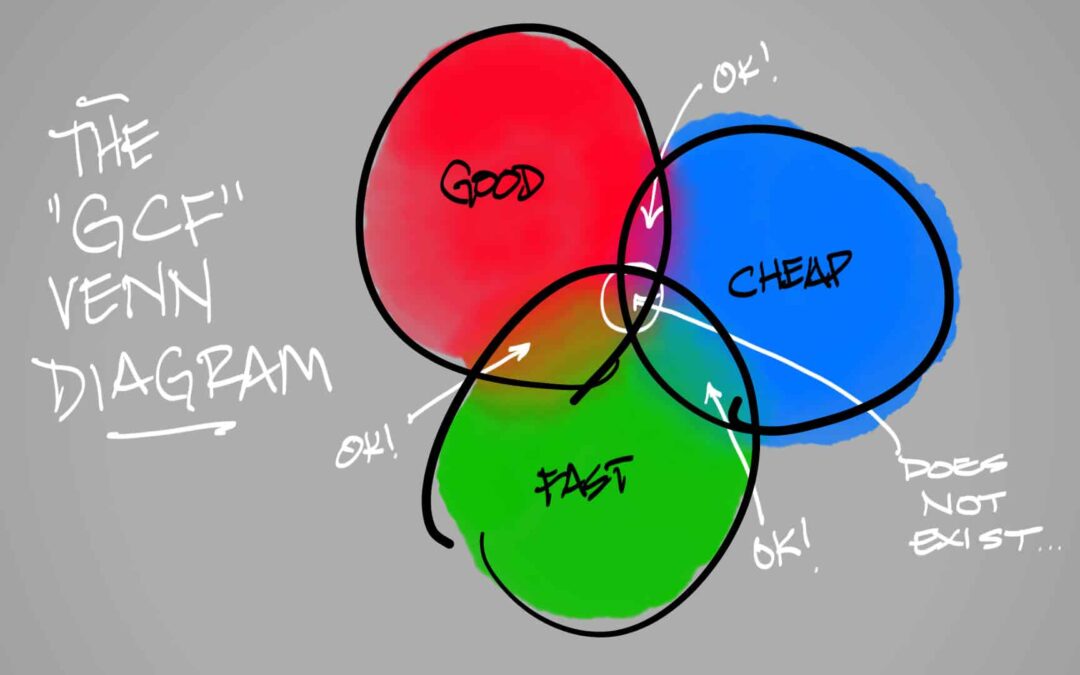I don’t know where the phrase first originated, but this has been one of a few mantra (mantras, mantri?) I feel like I am always saying over and over to anyone that will listen. It is of paramount importance to designers.
My grandfather had a Rolex watch. At least, that’s what he told everyone. If I remember correctly, however, a Rolex’s second hand turns smoothly. His ticked. That was a sign of a knockoff. But he would wink and tell you it wasn’t a “Rolecks”, it was the real deal.
The work of designers, and even more so of photographers, has been devalued in the last ten years or more. With so many avenues available on the internet for people to “create your own logo” and other tools, including motion graphics, collateral design and stock photography, people have multiple ways to create marketing materials for their companies.
But an old adage is “you get what you pay for.” This is apparent in the clothes we buy, the appliances we have, the computers we use. You can get cheap stuff these days, but is it “made like it used to be?” Nope.
Don’t be surprised when that “Apppple” computer starts puffing black smoke in the middle of a render.
Google the concept and you get a laundry list of pictures like the above and articles from a variety of industries on the subject. This one at Medium does a great job of breaking down the concept, and (albeit from a tech project perspective, but it applies to anything) discussing how to deal with the third spoke of the triangle that you deem less important). A great idea in the article speaks to agile processes:
…with an agile process you’re not choosing a fixed end point, you’re choosing a process to solve a problem.
This is a fundamental part of design that is missing a lot, in my experience, these days as well. Designers are experts in their field, and are brought to bear, supposedly, for that expertise. You would never go to a doctor, get a diagnoses and treatment regimen and say, “You know what, I think you are going to do this instead, Doc.” Unless you are a crazy person (you aren’t a crazy person, are you) you are going to defer to the expert. Not that there aren’t “good” experts and “not-so-good” experts, but hop in the boat with me while I make my point.
Most people want fast + cheap. They want it now, and they want it to not cost them a lot. We are all guilty of it. I think about this whenever I hire a plumber or landscaper. “Boy, that seems like a lot of money for that” always crosses my mind. But then I try to think about my own work, and what I charge for my services. And then I pay that contractor for good and fast, sacrificing cheap. Because that is what I want.
And remember, design is a service, believe it or not. It is not a product – a logo or video or whatever – it is the service of creating that thing. It is not the pretty thing you create. You can tell yourself that, and get a kick out of doing great work. But if you want to do good work and get paid well to do it, you need to stick to your guns on cost. And if your client wants it good, they have to sacrifice time or money. Otherwise they are getting a knockoff product. And you aren’t a knockoff, are you?
So, agile. Say a client wants a huge marketing push for their biz, but doesn’t have the budget to support it all at once. Parse it out, in stages. We’re good at that. Or the client has a huge budget and needs an event planned in three weeks. Rely on simple ideas and executions that achieve the goals quickly, but maybe aren’t going to grace the pages of Graphis.
So, if I client needs something good, and cheap, and fast, they are going to have to de-prioritize something. And they are going to have to trust their designer’s expertise to help them do that (I drew a diagram for you at the top, if you need a reference). That is the agile process. “I know you said you want A, B and C, but let’s think about A, B and X. That’s going to get you closer to what you need.” Replace the variables with actual words that make sense.
But for lots of people, they want to drive. They don’t want to use their experts and defer to their expertise. I once had a colleague ask me to quote him a logo/letterhead package for his multi-million dollar business. In the end, he went to an online service that would charge him $50 for it. Later, when showing me what he got, he shrugged and said, “It’s ok.” That’s right, it is “ok.” It was fast and cheap and that was what he valued more than good. But it was not good.
So, don’t sell yourselves short. Your time is valuable. Your skills are valuable. Your costs are valuable. And potential clients need to decide what two of those things they value as well. And it is ok to turn down work if it doesn’t meet those requirements.
Some people are ok with “Gukki” bags, after all.

